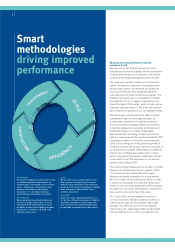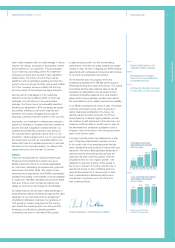Carphone Warehouse 2006 Annual Report Download - page 20
Download and view the complete annual report
Please find page 20 of the 2006 Carphone Warehouse annual report below. You can navigate through the pages in the report by either clicking on the pages listed below, or by using the keyword search tool below to find specific information within the annual report.
Financial Performance continued
Total investment increased from £159.9m to £351.1m
year-on-year. In addition to the acquisitions noted
above, the increase reflects an uplift in subscriber
acquisition costs from £25.6m to £51.6m, and a
substantial increase in investment in the Group’s IT
systems and infrastructure.
Balance sheet
The investment described above resulted in an
increase in non-current assets from £730.3m to
£1,014.9m year-on-year.
Acquisitions and organic growth in both Distribution
and Telecoms Services are reflected in an increase in
trade and other receivables from £353.9m to £554.5m.
Correspondingly, there is a year-on-year increase in
trade and other payables from £458.7m to £642.0m.
Provisions have increased from £57.8m to £123.5m
during the year, reflecting reorganisation costs and
other provisions associated with Onetel, and an
increase in sales provisions, principally in respect
of “cashback” promotions, the anticipated costs
of which are provided for on sale.
Net deferred tax assets have increased from £0.5m
to £34.9m, the largest driver of which is deferred
tax on share-based payments.
Financing and treasury
The Group’s operations are financed by committed
bank facilities, retained profits and equity. During the
period, the Group increased the revolving credit facility
that was originally signed in September 2004 to £450m.
This increased facility will expire in September 2009.
New term loans, totalling £275m, were also agreed
during the period, both to refinance the existing term
loan and to assist with the acquisition of Onetel in
December 2005. A £225m term loan, which expires in
February 2011, was syndicated and was arranged by
HSBC PLC, ING Bank NV, London Branch and The
Royal Bank of Scotland PLC. A £50m bilateral facility
was agreed with The Royal Bank of Scotland (Ireland)
and this facility expires in December 2010. The terms of
all three facilities are similar and the covenant packages
are identical.
Net borrowings peaked at the end of 2005, mainly
as a result of the Onetel and Tele2 UK acquisitions
and the high working capital levels required during
the peak Christmas trading period. The Group seeks
to maintain comfortable headroom on its committed
facilities at all times.
In addition to the revolving credit facility, the Group
has a number of uncommitted loan facilities, overdrafts
and guarantee lines – all technically repayable on
demand – which enable it to optimise cash
management efficiency, particularly at times of peak
working capital requirements. Cash and investments
held for insurance purposes of approximately £77m
(2005: £89m) are not immediately available to the
Group. These funds are invested to maximise returns
whilst ensuring at all times that such investments
are within acceptable risk parameters.
Funding of our subsidiaries is arranged centrally.
All cross-border funding is provided on an arm’s
length basis and currency risk is hedged using
foreign exchange swaps or currency borrowings,
as appropriate, at all times. Other than through
inter-company loans and capital funding, balance
sheet translational risk is not hedged against adverse
movements in exchange rates and the results of any
such movements are taken to reserves. The Group
is exposed to limited cross-border transactional
commitments and, where significant, these are hedged
at inception using forward currency contracts.
Treasury policy permits the use of long-term derivative
treasury products for the management of currency
and interest rate risk and the Group’s interest rate
exposures are monitored regularly. The Group does
not trade or speculate in any financial instruments.
Return on capital employed
Total shareholders’ funds at March 2006 were
£619.0m, compared to £548.0m at March 2005.
After taking into account average net debt, and
adjusting for the amortisation of acquisition intangibles
and goodwill arising on historic minority acquisitions,
the Group generated a return on capital employed
of 16.9% (2005: 17.8%).
Assuming a weighted average cost of capital for
the period of 6.6% (2005: 6.9%), this represents
an increase in economic value added from £52.0m
to £69.4m, being 11.0% and 10.3% respectively.
Roger Taylor, Chief Financial Officer
The Carphone Warehouse Group PLC Annual Report 2006
16
























